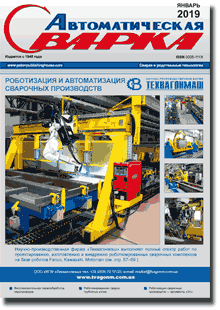| 2019 №01 (04) |
DOI of Article 10.15407/as2019.01.05 |
2019 №01 (06) |

Avtomaticheskaya Svarka (Automatic Welding), #1, 2019, pp. 40-43
Effect of magnetic field on crystallization of welds in arc welding
A.D. Razmyshljaev1, M.V. Ageeva2
1State Higher Eductation Instittue Pryazovskyi State Technical University. 7 Universitetskaya Str., 87500, Mariupil, Ukraine. Е-mail: razmyshljаеу@gmail.com
2Donbass State Machine Building Academy. 72 Akademicheskaya Str., 84313, Kramatorsk, Ukraine. Е-mail: maryna_ah@ukr.net
A review of publications on metallurgical and casting industry showed that analyzing the properties of liquid metals and alloys, many authors proceed from the notions of their cluster structure. The cluster structure of the liquid is a hypothesis, but it is confirmed by investigations of diffractions of X-rays, electrons and neutrons reflected from its surface. The work considers the existing notions about the fact, that a cluster is a crystal-like concentration of atoms. Around the clusters a softening zone exists, which consists of disordered atoms, the volume of which does not exceed 3...5 %, and this provides the fluidity of many melts. The authors of publications achieved successes in explaining the forming structure of ingots, based on the cluster mechanism of the process of crystallization of liquid metals and alloys. The authors of this work suggested that overheated molten metal at the head part of the pool, which has smaller clusters, moves under the action of magnetic fields to its tail part, and provides a refinement of the primary structure of the weld metal. 20 Ref., 1 Fig.
Keywords: welding, weld pool, magnetic field, cluster, weld structure, crystallization
Received: 23.10.2018
Published: 20.12.2018
References
1. Chernysh, V.P., Kuznetsov, V.D., Briskman, A.N. et al. (1983) Welding with electromagnetic stirring. Kiev, Tekhnika [in Russian].
2. Razmyshlyaev, A.D., Ahieieva, M.V. (2014) Features of arc surfacing process in a longitudinal magnetic field. Appl. Mech. Mater., 682, 313–318. https://doi.org/10.4028/www.scientific.net/AMM.682.313
3. Razmyshlyaev, A.D., Vydmysh, P.A., Ageeva, M.V. (2017) Automatic submerged-arc welding under action of external magnetic field. Mariupol, PGTU [in Russian].
4. Razmyshlyaev, A.D., Ageeva, M.V. (2018) On mechanism of weld metal structure refinement in arc welding under action of magnetic fields (Review). The Paton Welding J., 3, 25–28. https://doi.org/10.15407/tpwj2018.03.05
5. Chalmers, B. (1968) Theory of solidification. Moscow, Metallurgiya [in Russian].
6. Flemings, M. (1977) Processes of solidification. Moscow, Mir [in Russian].
7. Bagryansky, K.V., Dobrotina, Z.A., Khrenov, K.K. (1976) Theory of welding processes. Kiev, Vyshcha Shkola [in Russian].
8. Frolov, V.V. (1988) Theory of welding processes. Moscow, Vysshaya Shkola [in Russian].
9. Gavrilin, I.V. (2000) Melting and crystallization of metals and alloys. Vladimir, Vladimir. Un-t [in Russian].
10. Tolochko, N.K., Andrushevich, A.A. (2013) Cluster structure of melts. Litio i Metallurgiya, 73(4), 59–63 [in Russian].
11. Zhukova, L.A. (2002) Structure of metallic liquids: Manual. Ekaterinburg, UGTU-UPI [in Russian].
12. Skrebtsov, A.M., Ivanov, G.A., Sekachev, A.O. et al. (2006) New method for determination of number of atoms in metal melt cluster. Visnyk Pryazov. DTU: Transact., 16, 1–7.
13. Skrebtsov, A.M. Structure of liquid metals in liquidus-boiling temperature range. Protsessy Litiya, 3, 3–7 [in Russian].
14. Najdek, V.L., Melnik, S.G. (2015) Clusters — the structural constituents of metal melts. Metall i Litio Ukrainy, 266(7), 21–33 [in Russian].
15. Aganaev, Yu.P. (2014) Formation of structure of metal alloys under conditions of energy inhomogeneity of phase interface in periodic crystallization. Sovrem. Naukoyomkie Tekhnologii, 9, 6–10 [in Russian].
16. Stetsenko, V.Yu. (2015) Clusters in liquid metals — stable nanocrystals. Litio i Metallurgiya, 79(2), 33–35 [in Russian].
17. Marukovich, E.I., Stetsenko, V.Yu. (2015) Main difficulties of modern theory of metal melt. Ways to overcome. Litio i Metallurgiya, 84(3), 24–27 [in Russian].
18. Ivanov, I.A. (2007) Kinetic phase transition in crystallization of metals from melt: Syn. of Thesis for Cand. of Phys.-Math. Sci. Degree. Moscow [in Russian].
19. Deev, V.B., Tsetsorina, S.A., Selyanin, I.F., Prikhodko, O.G. (2003) Some peculiarities of cluster model of metal melts. Polzunovsky Almanakh, 3, 141–149 [in Russian].
20. Frumin, I.I. (1961) Automatic electric arc surfacing. Kharkov, Lit-ra po Chyornoj i Tsvetnoj Metallurgii [in Russian].
17. Marukovich, E.I., Stetsenko, V.Yu. (2015) Main difficulties of modern theory of metal melt. Ways to overcome. Litio i Metallurgiya, 3(84), 24-27 [in Russian].
18. Ivanov, I.A. (2007) Kinetic phase transition in solidification of metals from melt. In: Syn. of Thesis for Cand. of Phys.-Math. Sci. Degree. Moscow [in Russian].
19. Deev, V.B., Tsetsorina, S.A., Selyanin, I.F., Prikhodko, O.G. (2003) Some peculiarities of cluster model of metal melts. Polzunovsky Almanakh, 3, 141-149 [in Russian].
20. Frumin, I.I. (1961) Automatic electric arc surfacing. Kharkov, Lit-ra po Chyornoj i Tsvetnoj Metallurgii [in Russian].
